
Sandra Olsen is wild about horses — and the humans who herd them. Find out what she does as a zooarchaeologist, and what she has learned about how people have tamed and bred horses over time.
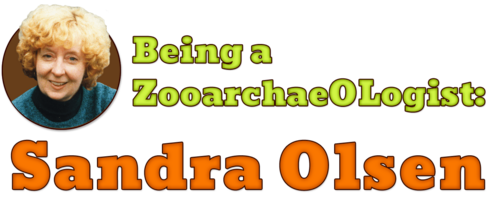
Sandra Olsen is wild about horses — and the humans who herd them. Find out what she does as a zooarchaeologist, and what she has learned about how people have tamed and bred horses over time.
1. What is a zooarchaeologist?
Sandra Olsen: Well, let's break that huge name into two parts: zoo and archaeology . "Zoo," of course, relates to animals. And an archaeologist studies how people lived in the past. So a zooarchaeologist studies the relationship between humans and animals in ancient times.
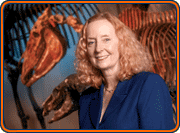
Dr. Sandra Olsen is a zooarchaeologist. She is also a curator at the Carnegie Museum of Natural History.
2. What do you study?
Sandra: As a zooarchaeologist, I specialize in horses and their impact on human society. For the past 15 years, I've been studying early horse domestication . In other words, I study when humans stopped hunting wild horses and started keeping them in herds as livestock.
During the Ice Age, people hunted horses for meat. So their relationship at that time was one of predator and prey. About 6,000 years ago, people started settling down into permanent villages. They began to domesticate horses so they would always have meat.
But this happened over time. We can tell from archaeological finds that people did not suddenly stop hunting wild horses. Even when they were developing domestic herds, they were also hunting wild horses, cattle, deer and other large game—probably on horseback!
In my work, I'm interested in this shift in the relationship between people and horses, from predator and prey to herder and livestock.
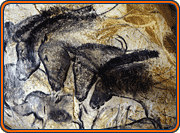
Horses appear often in European cave art.
3. Why was the domestication of horses so important?
Sandra: Domestication means the taming and breeding of animals. And I think that the horse is probably the most important animal that was ever domesticated by humans!
At first, people depended on horses for food. Horsemeat was an important part of the diet on the Eurasian Steppes. The Steppes are a broad, flat plain that stretches from Hungary to Mongolia.
Within a short time people began to milk the mares, or female horses, for their nutritious milk, called koumiss.
Before long, people began to ride horses. From there, people started using horses to pull wagons and chariots. And eventually horses were used in warfare. Cavalries, or groups with soldiers riding on horseback, proved much more powerful than armies on foot. And that led to enormous empire building.
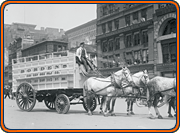
Before cities had subways, people rode in horse-drawn streetcars.
4. How have horses changed human history?
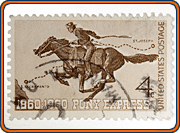
Before railroads and cars, people used horse relay systems like the Pony Express to carry mail across the country.
Sandra: In so many ways! To my mind, horses have made a bigger impact on human society than any other animal.
Horses provided the first means of fast travel. This sped up migration, trade, and communication between cultures. They helped languages and cultures spread around the world. They helped people do work, from plowing fields to hauling goods. And horses contributed to human status, religion, and sports.
Horses have also played a critical role in warfare. Some of the major empire builders of the world — Alexander the Great, Attila the Hun, Genghis Khan — were able to expand their vast territories through the use of cavalries.
5. Where and when were horses first domesticated?
Sandra: Archaeologists have done a lot of research to answer that question! It probably happened around 6,000 years ago on the Eurasian grasslands. In fact, it probably happened in Ukraine, western Russia, or northern Kazakhstan. Horses lived in these places at that time.
But in my research, I'm not so concerned with the very first domestication of the horse and when and where it happened. I'm more interested in looking at the process — how it happened.
That's why I'm investigating the settlements of the Botai culture, located in northern Kazakhstan in Central Asia. The Botai people were probably not the first to tame and breed horses, but were certainly very early horse herders. They lived during what we called the Copper Age, about 5,500 years ago. It may not represent the very first example. But it does provide us with a lot of evidence for how the process of horse domestication began.
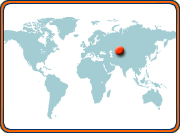
Sandra researches in Kazakhstan. This country is in Asia.
6. Why are scientists investigating the site at Krasnyi Yar? What questions do you hope to answer?
Sandra: Krasnyi Yar was a site of the Botai culture. The Botai people lived between 3700-3100 BC. The ancestors of the Botai people were once nomadic horse hunters. They didn't have a permanent home and traveled from place to place. Eventually, they began living in permanent settlements.
Krasnyi Yar is one of four Botai culture sites we've identified. It was a smaller village of the Botai, with about 54 houses. It holds important clues about early horse herding.
Scientists like myself are looking for evidence that will teach us about the domestication of horses — not just if or when it happened, but how it happened. We ask questions like: How did they tame these wild animals? How did they care for and breed the horses?
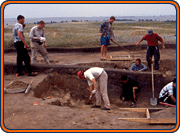
Scientists dig for evidence. They want to know how the early Botai people tamed and bred horses.
7. What can you learn from horse bones you find?
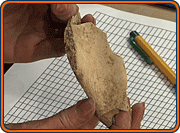
Sandra examines a horse bone found at Krasnyi Yar. It displays cut marks from butchery.
Sandra: We found over 300,000 horse bones at the Botai sites. That's a lot of bones! All this evidence tells us many things.
First, the horse bones help us estimate the number of horses that were there. To do this, we look for the most common bones in the collection, like a right leg bone. We count these bones and consider that to be the minimum number of horses at that site. (Of course, there may have been more bones that were not preserved.)
We've also noticed that up to 98 percent of the animal remains found at the site are identified as horse. This tells us that the diet of the Botai people was almost completely horsemeat.
And we've found cut marks on the bones. These marks were made by stone tools. This evidence suggests that the Botai people butchered the horses. Marks on the bones and bone fragments also tell us which parts of the horse's body they used. For example, it appears they cracked open the bones to remove marrow, or fat. This would have been an important source of calories to help people survive the harsh winters of the Siberian plain.
To separate cut marks from natural marks on the bones, I study the bones carefully. I first look at them just with my eyes and then I'll use a hand lens. And, if I still have questions, I'll use either a stereomicroscope or, in some cases, a scanning electron microscope .
8. What can't you learn from horse bones?
Sandra: Horse bones don't tell the whole story. When other species, like the dog or the pig, are domesticated, scientists can usually see a change in the bones.
When scientists compare the skeletons of wild and domesticated horses, we see virtually no change in their size or skull shape. So we can't use horse skeletons to identify early horse domestication.
What we have to do instead is to take a holistic approach. In other words, we look at every aspect of the Botai settlement and the artifacts within it.
And my idea is that, if you cannot see domestication in the horse skeleton itself, then perhaps you can look at how the domestication of the horse changed humans. So we look at how the humans changed their behavior, settling down in large, permanent villages.
We try to imagine how they could live in such large villages year-round if they were just hunting wild horses. They would need a steady supply of meat. We look at the stone tools they were using — how they were made and what materials they used. Then we look at the distance that they travel to get things like stone, which is very heavy. They would need packhorses to carry that heavy load a long distance.
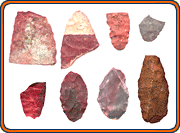
These stone tools were found at Krasnyi Yar.
9. What other kinds of scientists do you work with?
Sandra: I work with scientists from a wide range of fields. Our team is very diverse, and each scientist is an expert at what he or she does.
For example, physicists do remote sensing. Using special equipment, they are able to look beneath the ground surface. They can see where the house foundations are and how they're laid out.
Biochemists look at residues in our pottery to identify traces of horsemeat. They may even find traces of mare's milk.
Geochemists use chemical analysis to help us identify where horse corrals were within those settlements. Corrals are fenced areas where people keep livestock like horses.
We even have experts on stone tools, on pollen, and on plant remains. And I'm doing analysis on animal bones. With this approach, we work together like a forensics team. We look at all the evidence, not just the horse bones.
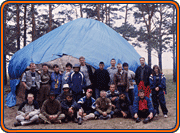
Sandra works with many people to excavate the dig site and analyze the evidence. It takes a team of scientists to make this happen!
10. What are some of the main pieces of evidence that the Botai domesticated their horses?
Sandra: One of our biggest finds has been the identification of corrals. These were areas where the Botai people kept horses. On the open plains, they had to have places where horses were contained when not grazing.
To identify these corrals, we first look for a series of postholes where fence posts were once planted. These postholes formed large, circular areas within the village.
Then geochemists analyzed the soil. They found high levels of phosphates and nitrogen inside those areas. This chemical evidence is a sign of a concentration of manure. And because the Botai people had no other domestic livestock, it had to be horse manure.
We also observed another kind of evidence: there was a change in the way the Botai people made stone tools. When they were nomadic horse hunters, they would make very lightweight blades at the place where stone was found. But then, they began bringing stone in large quantities from the nearest stone source, which was 14 kilometers (8.6 miles) away, back to the settlement. And they made heavier, chunkier stone tools. They may have used packhorses to carry stones such long distances.
We've also found many examples of a tool called a thongsmoother. It's simply a horse jaw with the teeth removed. It is used to straighten and stretch long strips of rawhide. Horse herders really need these strips for bridles, lassos, whips, and other ways of controlling horses. We've found so many of these artifacts, we know that they were probably controlling the horses.
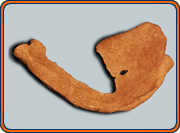
This thongsmooter is about 20 cm (8 in) long. It was used by the Botai people to make long rawhide strips.
11. What do you learn about horses by studying the buildings and other human artifacts?
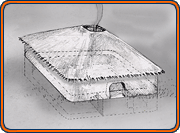
Based on evidence, an artist made a drawing of what a Botai pithouse may have looked like.
Sandra: We can learn a lot by studying the size and complexity of Krasnyi Yar and the other Botai settlements. They had large, well-planned villages with 40 to 160 houses lined up along avenues and around plazas. This tells us that the people were able to stay in one place year-round. Since they had no agriculture, they had to count on horses. Therefore, they must have had domesticated herds.
Their belongings also tell a story. The Botai people had more pottery and heavier stone tools than you would expect for nomadic hunters.
12. What role did horses play in the religion of the Botai?
Sandra: Well, we know that the Botai sacrificed horses. Around the exterior of a house, we found pits containing really interesting animal remains. Among the remains were five horse skulls and necks. They were pointing toward the rising Sun — northeast, east or southeast — depending on the season when the animal is sacrificed. This evidence suggests that the horse may have played an important role in their religious practice.
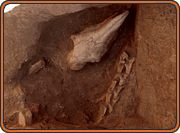
At Krasnyi Yar, scientist found a sacrificial pit outside a pithouse. It contained a horse skull and neck.
13. How do you figure out what a Botai village might have looked like?
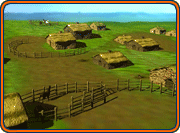
Scientists created a computer-generated image of the Krasnyi Yar village.
Sandra: Based on our excavations , we have determined that the houses were square and made of adobe. They were pit houses, meaning that half of the house was underground. And through microscopic soil analysis, we concluded that the sapling roofs were insulated with horse manure. That may sound unusual, but manure is used all over the Eurasian Steppes to insulate buildings and keep them warm. People still use manure to insulate stables today.
We also do computer models to reconstruct what the houses looked like. These models helped us understand the lifestyle of the Botai people.
By doing a computer reconstruction of the village, we also can better understand the society and their relationships with the horses. We see they had central plazas, how close together the houses were, and where the corrals were located.
14. Can modern cultures in Kazakhstan help you understand the ancient Botai?
Sandra: Absolutely. Although the modern Kazakhs are not descendants of the Botai people, their lifestyles are very similar. They live in small villages with herds of horses. The Kazakhs also raise cattle and sheep. The environment is also the same.
By studying the modern-day Kazakhs, we can better understand how they care and feed the animals, grazing them through the night, how they seasonally butcher the horses in December, how they milk the mares during the warmer months, and their general relationship to the horses.
Modern-day Kazakhs have also shown us how useful horse byproducts are, such as their milk and manure. They still use manure for fuel to heat the houses. It is also used as building material, particularly to insulate the roofs.
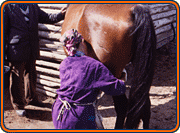
The Kazakhs use mare's milk to make a fermented milk beverage known as koumiss.
15. What do you enjoy most about your research?
Sandra: To me, what's most fun about my research is trying to reconstruct the daily lives of the Botai.
I imagine how horse herders lived out on the Steppes, dealing with bad weather and all of the disadvantages and advantages of that environment.
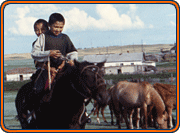
Young Kazakh herders drive horses near their village.
Image Credits:
Sandra Olsen, excavation, horse bone with cut marks, stone tools, team of scientists, thongsmoother, sacrificial pit, woman milking mare, boys riding horse: © Sandra Olsen Chauvet cave painting: © Jean Clottes horse pulling streetcar: © Library of Congress Pony Express stamp: ©; L. Cunliffe / AGE Fotostock world map showing Kazakstan: © AMNH artist reconstruction of Botai pithouse: © Mark Klingler computer model of Krasnyi Yar village: © Ashley Brickman The Horse exhibition: © AMNH / Denis Finnin




 Biodiversity
Biodiversity
 Brain
Brain
 Genetics
Genetics
 Marine BiOLogy
Marine BiOLogy
 MicrobiOLogy
MicrobiOLogy
 PaleontOLogy
PaleontOLogy
 ZoOLogy
ZoOLogy
 AnthropOLogy
AnthropOLogy
 ArchaeOLogy
ArchaeOLogy
 Astronomy
Astronomy
 Climate Change
Climate Change
 Earth
Earth
 Physics
Physics
 Water
Water
